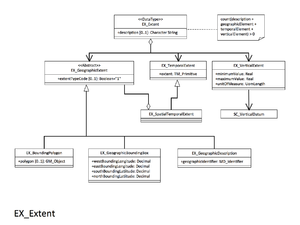TimePeriod
From Earth Science Information Partners (ESIP)
gml:TimePeriod
| Elements | Domain | Definition and Recommended Practice | Examples | ||
|---|---|---|---|---|---|
| 1 | gml:description | 0..1 | xsd:string | Textual description of the date and time documented. | |
| 2 | gml:descriptionReference | 0..1 | xsd:string | ||
| 3 | gml:identifier | 0..1 | xsd:string | ||
| 4 | gml:name | 0..* | xsd:string | ||
| 5 | gml:relatedTime | 0..* | gml:TM_Primitive | ||
| 5 | gml:beginPosition | 1 | xsd:date xsd:dateTime |
The beginning date or date and time of the resource contents. Use the ISO 8601 extended standard: YYY-MM-DD or YYY-MM-DDThh:mm:ssZ. | beginPosition: 2010-06-05T12:00:17 |
| 6 | gml:endPosition | 1 | xsd:date xsd:dateTime |
If the resource has a status of 'ongoing' then use the indeterminatePosition attribute without an end date value. The ending date or date and time of the resource contents. Use the ISO 8601 extended standard: YYY-MM-DD or YYY-MM-DDThh:mm:ssZ. |
endPosition: 2010-06-05T12:00:17 endPosition: indeterminatePosition="now" |
| 7 | gml:duration | 0..1 | xsd:duration | Provide either gml:duration or gml:timeInterval if applicable. Length of time between measurements. Use the ISO 8601 syntax for temporal length. |
duration: P1D |
| 8 | gml:timeInterval | 0..1 | xsd:decimal | Provide either gml:duration or gml:timeInterval if applicable. Frequency between time events based on floating point values for temporal length. |
timeInterval unit="hour": 1.0 |
Please contribute!
<gml:TimePeriod gml:id="someTimeID"> <gml:beginPosition>1846</gml:beginPosition> <gml:endPosition indeterminatePosition="now"/> </gml:TimePeriod>
<gml:TimePeriod gml:id="timeId"> <gml:beginPosition>1992-01-01T00:00:00Z</gml:beginPosition> <gml:endPosition>2007-12-31T00:00:00Z</gml:endPosition> <gml:timeInterval unit="hour">6</gml:timeInterval> </gml:TimePeriod>


